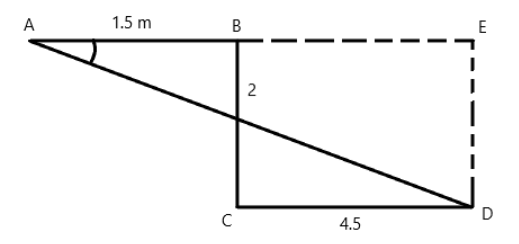Answer
385.8k+ views
Hint The total distance is simply the sum of all the little distances travelled. The displacement can be said to be the length of the line drawn from the start of the journey to the end of the journey.
Formula used: In this solution we will be using the following formulae;
\[hy{p^2} = op{p^2} + ad{j^2}\] where \[hyp\] signifies hypotenuse side of a right angled triangle, \[opp\] is opposite side, and \[adj\] is the adjacent side.
Complete Step-by-Step solution:

As shown in the diagram above, man travels east (which is rightward) \[1.5\] m, then he travels south 9which is downward) 2 m, and finally east again by \[4.5\] m.
To calculate the total distance travelled, we simply sum of the entire short distances. We do that as follows,
\[{d_t} = {d_{AB}} + {d_{BC}} + {d_{CD}}\]which by insertion of given values will be
\[{d_t} = 1.5 + 2 + 4.5 = 8m\]
Hence, the total distance covered is equal to 8 m.
Now to calculate the displacement, we draw a line from the beginning of the journey to the end, and calculate its length.
From the diagram, we can see that the triangle ADE is a right angled triangle, hence, we the line AD is which is the displacement is the hypotenuse of the triangle. Hence, from Pythagoras theorem
\[hy{p^2} = op{p^2} + ad{j^2}\]where\[hyp\] signifies hypotenuse side of a right angled triangle, \[opp\] is opposite side, and \[adj\] is the adjacent side.
We have that the displacement \[l\] can be calculated from
\[{l^2} = {\left( {1.5 + 4.5} \right)^2} + {2^2} = {6^2} + {2^2}\]
\[ \Rightarrow {l^2} = 40\]
Hence, by using square root, we have that
\[ \Rightarrow l = \sqrt {40} = 2\sqrt {10} m\]
For the direction, we have that
\[\tan \theta = \dfrac{{{d_{ED}}}}{{{d_{AE}}}} = \dfrac{2}{6}\]
\[\theta = {\tan ^{ - 1}}\left( {\dfrac{1}{3}} \right) = 18.4^\circ \]
Hence, the direction is \[18.4^\circ \] from the east towards the south.
Note: Note that, because displacement is a vector, it is imperative that when told to calculate it, the direction must be included unless where told otherwise. This is often a common mistake.
Formula used: In this solution we will be using the following formulae;
\[hy{p^2} = op{p^2} + ad{j^2}\] where \[hyp\] signifies hypotenuse side of a right angled triangle, \[opp\] is opposite side, and \[adj\] is the adjacent side.
Complete Step-by-Step solution:

As shown in the diagram above, man travels east (which is rightward) \[1.5\] m, then he travels south 9which is downward) 2 m, and finally east again by \[4.5\] m.
To calculate the total distance travelled, we simply sum of the entire short distances. We do that as follows,
\[{d_t} = {d_{AB}} + {d_{BC}} + {d_{CD}}\]which by insertion of given values will be
\[{d_t} = 1.5 + 2 + 4.5 = 8m\]
Hence, the total distance covered is equal to 8 m.
Now to calculate the displacement, we draw a line from the beginning of the journey to the end, and calculate its length.
From the diagram, we can see that the triangle ADE is a right angled triangle, hence, we the line AD is which is the displacement is the hypotenuse of the triangle. Hence, from Pythagoras theorem
\[hy{p^2} = op{p^2} + ad{j^2}\]where\[hyp\] signifies hypotenuse side of a right angled triangle, \[opp\] is opposite side, and \[adj\] is the adjacent side.
We have that the displacement \[l\] can be calculated from
\[{l^2} = {\left( {1.5 + 4.5} \right)^2} + {2^2} = {6^2} + {2^2}\]
\[ \Rightarrow {l^2} = 40\]
Hence, by using square root, we have that
\[ \Rightarrow l = \sqrt {40} = 2\sqrt {10} m\]
For the direction, we have that
\[\tan \theta = \dfrac{{{d_{ED}}}}{{{d_{AE}}}} = \dfrac{2}{6}\]
\[\theta = {\tan ^{ - 1}}\left( {\dfrac{1}{3}} \right) = 18.4^\circ \]
Hence, the direction is \[18.4^\circ \] from the east towards the south.
Note: Note that, because displacement is a vector, it is imperative that when told to calculate it, the direction must be included unless where told otherwise. This is often a common mistake.
Recently Updated Pages
How many sigma and pi bonds are present in HCequiv class 11 chemistry CBSE

Why Are Noble Gases NonReactive class 11 chemistry CBSE

Let X and Y be the sets of all positive divisors of class 11 maths CBSE

Let x and y be 2 real numbers which satisfy the equations class 11 maths CBSE

Let x 4log 2sqrt 9k 1 + 7 and y dfrac132log 2sqrt5 class 11 maths CBSE

Let x22ax+b20 and x22bx+a20 be two equations Then the class 11 maths CBSE

Trending doubts
Fill the blanks with the suitable prepositions 1 The class 9 english CBSE

At which age domestication of animals started A Neolithic class 11 social science CBSE

Which are the Top 10 Largest Countries of the World?

Give 10 examples for herbs , shrubs , climbers , creepers

Difference between Prokaryotic cell and Eukaryotic class 11 biology CBSE

Difference Between Plant Cell and Animal Cell

Write a letter to the principal requesting him to grant class 10 english CBSE

Change the following sentences into negative and interrogative class 10 english CBSE

Fill in the blanks A 1 lakh ten thousand B 1 million class 9 maths CBSE



